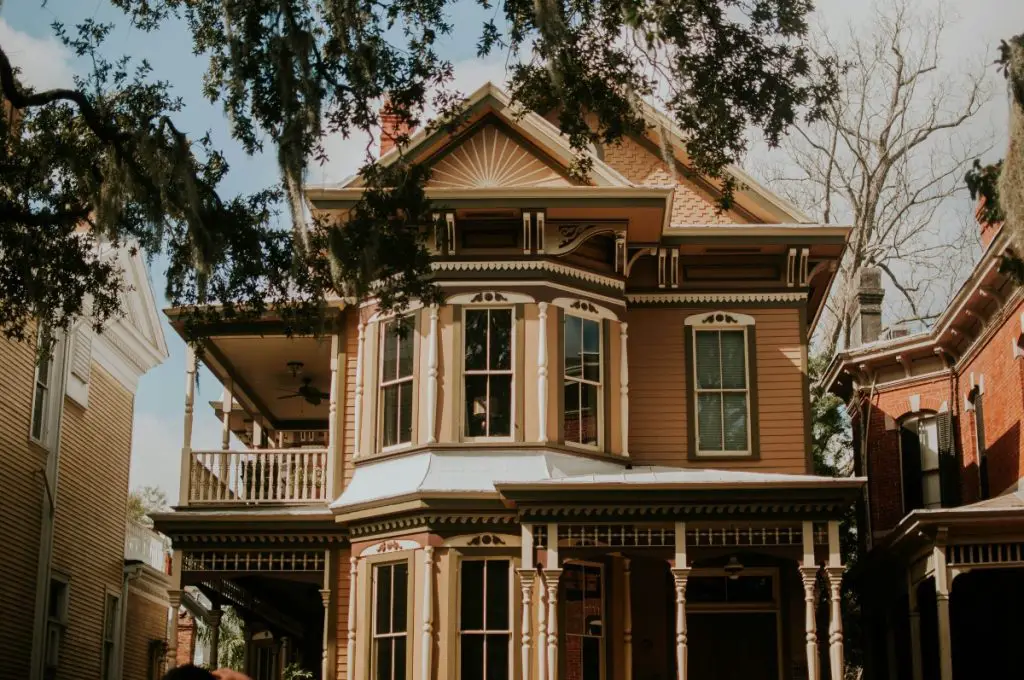Victorian homes embody an era of architectural grandeur. You will immediately know a house is Victorian-influenced due to its intricate design and features. In this post, we delve into the unique aspects of Victorian homes, unraveling their architectural features, historical context, and lasting impact on modern design.
Contents
- 1 Historical Context of Victorian Homes
- 2 Architectural Features of Victorian Homes
- 3 Interior and Exterior Design
- 4 Influence on Modern Architecture
- 5 FAQs About Victorian Homes
- 5.1 What defines a Victorian home?
- 5.2 When were Victorian homes popular?
- 5.3 Are Victorian homes energy efficient?
- 5.4 What are some common challenges of owning a Victorian home?
- 5.5 How have Victorian homes influenced modern architecture?
- 5.6 Can Victorian homes be modernized?
- 5.7 Why are stained glass windows popular among Victorian homes?
- 5.8 Are all Victorian homes large and elaborate?
- 5.9 How can I identify the style of a Victorian home?
- 5.10 Is it expensive to maintain a Victorian home?
- 6 Conclusion
Historical Context of Victorian Homes
Victorian homes, a symbol of 19th-century elegance, reflect an important chapter in architectural history. These homes, born during the reign of Queen Victoria, showcase a period marked by industrial progress and a rich cultural shift.
Emergence During the Victorian Era
The Victorian Era is the period of Queen Victoria’s rule from 1837 to 1901. It was during this time of British history that the peak of the Industrial Revolution when the middle class was increasing. This led to an advancement of technology, culture, and society, including the discovery of the telephone and photography.
This newfound prosperity directly impacted the housing sector, fueling a dramatic increase in the construction of Victorian homes. The architectural landscape of the time underwent a radical change. Architects and builders were driven by the Industrial Revolution, leading to the liberal use of iron and steel. It also drove the use of glass for decorative use.
Iron and steel were incredibly durable and resilient materials that allowed Victorian architects to accomplish exterior and interior designs unique to the era. As a result, Victorian homes started to exhibit more ornate and elaborate features, a stark contrast to the more straightforward designs of earlier periods.
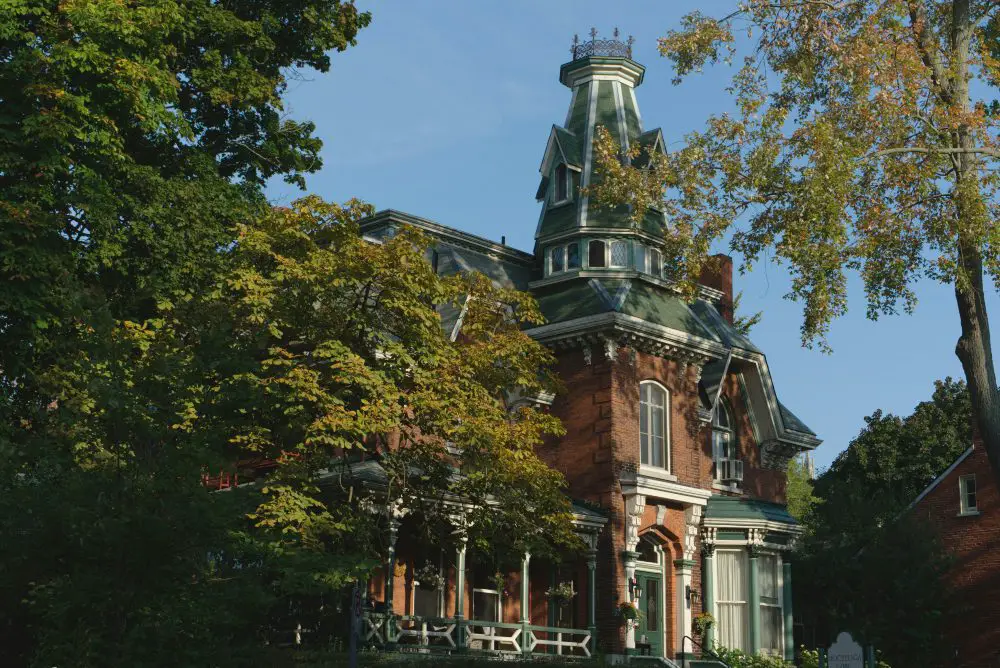
The Victorian homes of this era were characterized by their intricate detailing and decorative exteriors. Features like overhanging eaves, ornamental gables, and elaborate wood trim became commonplace.
Stained glass windows and bright, patterned bricks added color and vibrancy to these homes. Internally, advances in construction techniques enabled larger windows and higher ceilings, creating airy, light-filled spaces that departed from the darker, more enclosed rooms of previous architectural styles.
There was a shift towards customization and personalization in Victorian homes. Architects were also influenced by the philosophy of the Industrial Revolution with the incorporation of technology into their designs.
Homeowners and architects sought to make each house unique, with its character and style. This led to a diverse range of Victorian home styles, each with its distinct features yet all sharing the common thread of ornate and intricate design.
Victorian Homes are essentially the product of the Industrial Revolution with the prominent use of iron and steel. The advancements in technology and the rise in prosperity allowed for a new architectural style that was grand, elaborate, and rich in detail. Victorian homes from this era stand today as a testament to the innovation and creativity of the time.
Influences on Design and Architecture
The architectural design of Victorian homes was not a product of a single influence but rather a blend of multiple historical styles, each adding its unique flair. This eclectic fusion resulted in the rich and diverse tapestry of designs that characterize Victorian homes.
The Gothic Revival played a significant role in shaping Victorian homes. This style, inspired by medieval architecture, brought pointed arches, high-pitched roofs, and intricate woodwork.
Victorian homes incorporating this style often featured ornate gables, decorative tracery, and leaded glass windows, all elements that emphasized verticality and grandeur. The use of these Gothic elements added a sense of romanticism and historical grandiosity to Victorian homes, evoking the splendor of medieval cathedrals and castles.
The Italianate style, another key influence, drew inspiration from the villas of the Italian countryside. It introduced Victorian homes to flat or low-pitched roofs, wide eaves with ornate brackets, and imposing cornices.
The facades of these homes often featured tall, narrow windows, sometimes with elaborate window crowns. Balconies and cupolas were also common in Italianate Victorian homes, adding to their stately and elegant appearance. This style was particularly favored in urban settings, where its sophisticated and cosmopolitan feel stood out.
Through these designs, Victorian homes became more than just residences. They represented a fusion of art, culture, and innovation, reflecting the dynamic spirit of the era. Today, Victorian homes remain a cherished part of our architectural heritage, admired for their distinct charm and historical significance.
Architectural Features of Victorian Homes
Victorian homes are renowned for their distinctive architectural features. These features, a blend of various historical styles, create a unique aesthetic that is both intricate and elegant. In this section, we explore the key architectural elements that define Victorian homes, highlighting their complexity and beauty.
Ornate Facades
The facades of Victorian homes are immediately striking for their ornate nature. You can see it on the exterior itself where the edges, windows, archway, and doorway have complicated shapes.
The woodwork on these facades often includes elaborate scrollwork, finials, and gingerbread trim, creating a lace-like appearance that captivates the eye. Decorative features like gables, eaves, and brackets are not just functional but also artistically crafted, often with intricate patterns and motifs.
A common signature of an ornate facade is the combination of materials to achieve a specific texture. These combinations usually consist of stucco, shingles, and sidings. This ornamentation reflects the era’s preference for beauty and elegance, making each home a unique piece of art.

Asymmetrical Designs
Asymmetry is another hallmark of Victorian home architecture. Unlike the balanced and symmetrical designs of earlier periods, Victorian homes often feature irregular and unexpected layouts. Asymmetrical patterns are present on doors, windows, fences, arches, and other exterior parts of the house.
Many Victorian homes include bay windows, multiple gables, and varying roof lines, all contributing to a dynamic and visually interesting design. The inclusion of towers or turrets often enhances this asymmetry, adding a vertical dimension that breaks the horizontal monotony.
These asymmetrical designs not only add to the aesthetic appeal of Victorian homes but also reflect the era’s embrace of individuality and creative expression in architecture.
Decorative Trims and Moldings
Decorative trims and moldings are central to the charm of Victorian homes. These features are often intricate and elaborate, showcasing the era’s affinity for detail and craftsmanship.
Victorian homes frequently feature crown moldings, ceiling medallions, and cornices, each intricately carved and serving both aesthetic and functional purposes. The use of trims extends to the exterior as well, with corbels and spandrels adorning porches and eaves.
Inside, wood paneling and wainscoting add texture and depth to rooms, while carved stair railings and fireplace mantels stand as focal points of craftsmanship. These decorative elements are not merely ornamental; they embody the Victorian era’s dedication to beauty and refinement in every aspect of home design.
Turrets and Towers
Turrets and towers are among the most distinctive features of Victorian homes, lending them a grand, almost fairytale-like quality. These structures often rise above the main roofline, providing a sense of majesty and height.
Turrets in homes are small versions of those cylindrical structures in castles that provide a panoramic view of one’s surroundings. Towers, on the other hand, maybe square or round and are often more centrally located. They serve not only as architectural statements but also as functional spaces, like a reading nook or a small study area.
The addition of turrets and towers to Victorian homes reflects the era’s fascination with eclectic, whimsical designs that push the boundaries of traditional architecture.
Stained Glass Windows
Stained glass windows are a captivating feature of many Victorian homes, adding both color and artistry to their design. These windows often depict intricate patterns or scenes, incorporating vibrant hues that catch the light in mesmerizing ways.
Beyond their aesthetic appeal, stained glass windows in Victorian homes serve a functional purpose by providing privacy while allowing natural light to filter through. The designs range from simple geometric patterns to elaborate floral or figurative motifs, each reflecting the homeowner’s taste and the era’s artistic trends.
Wrap-Around Porches
Wrap-around porches are a signature element of many Victorian homes, epitomizing the era’s emphasis on leisure and outdoor living. These porches extend around one or more sides of the house, offering ample space for relaxation and socializing.
They are often adorned with decorative railings, spindles, and brackets, consistent with the ornate style of Victorian architecture. Wrap-around porches not only enhance the home’s curb appeal but also blur the line between indoor and outdoor spaces, encouraging residents to enjoy the natural surroundings. With the right flooring material, the porch serves as a grand entrance, welcoming guests with its spacious and inviting presence.
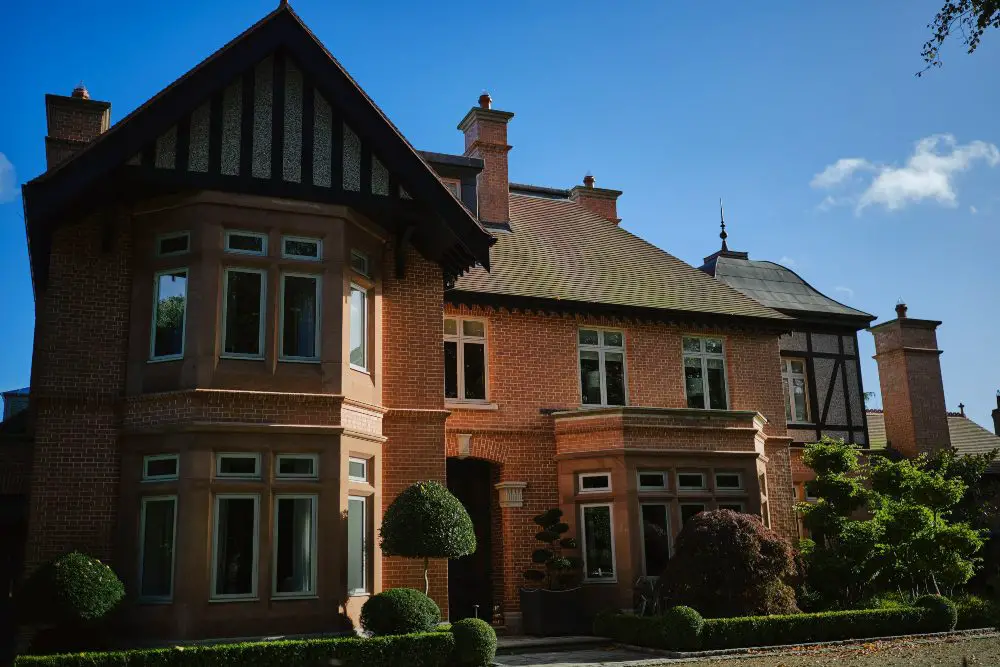
High-Pitched Roofs and Gables
High-pitched roofs and gables are distinctive architectural elements of Victorian homes, contributing to their dramatic and imposing appearance. The steep rooflines serve a practical purpose, aiding in water runoff and snow shedding, but they also have a strong aesthetic appeal.
Gables, often ornately decorated with trim and woodwork, add further visual interest to the roofline. The complexity of these roofs often includes varying angles and intersecting planes, creating a dynamic and visually engaging silhouette.
Dormer windows are commonly added to these high-pitched roofs, providing additional light and space in the upper levels of the home. This architectural feature not only defines the Victorian home’s exterior but also creates distinctive, cozy spaces within.
Bright and Varied Color Schemes
The color schemes of Victorian homes are a visual celebration, distinctively bright and varied, setting them apart from the more restrained palettes of previous architectural eras. These homes are renowned for their bold and often unexpected color combinations that highlight the intricate details of their exteriors. In a Victorian streetscape, it’s common to find homes painted in a spectrum of hues, each one telling a unique story through its choice of color.
The use of vibrant colors is not merely for aesthetic pleasure; it plays a crucial role in accentuating the architectural features of these homes. Ornate trims, moldings, and decorative elements come alive under the influence of these rich colors. This polychromatic approach is a direct reflection of the Victorian era’s embrace of experimentation and individual expression. During this time, homeowners and architects were not afraid to experiment with color, using it as a tool to express personality and stand out.
Color palettes used by Victorian homes can range from brown earthy tones to bright blue tones. The color scheme is about inserting a specific personality in each space. This variety in color choice adds an individual character to each home, making every Victorian house unique. It’s not uncommon to see a Victorian home with a base color complemented by two or more accent colors, each chosen to highlight different architectural features.
This bold use of color has ensured that Victorian homes continue to capture our imagination and admiration. The lively and diverse color schemes of these homes are more than just a choice of paint; they are a celebration of the era’s artistic freedom and creativity. These colors contribute significantly to the enduring charm and appeal of Victorian homes, making them not just structures from a bygone era but vibrant, living pieces of history.
Interior and Exterior Design
The design of Victorian homes, both inside and out, reflects an era of opulence, attention to detail, and a celebration of artistic expression. These homes are characterized by their unique blend of grandeur and intricacy, a testament to the architectural innovation of the Victorian era.
Interior Design
The interior design of Victorian homes mirrors the elaborate and ornate style of their exteriors. Each room is crafted with attention to detail, creating spaces that are not just functional but also artistically appealing.
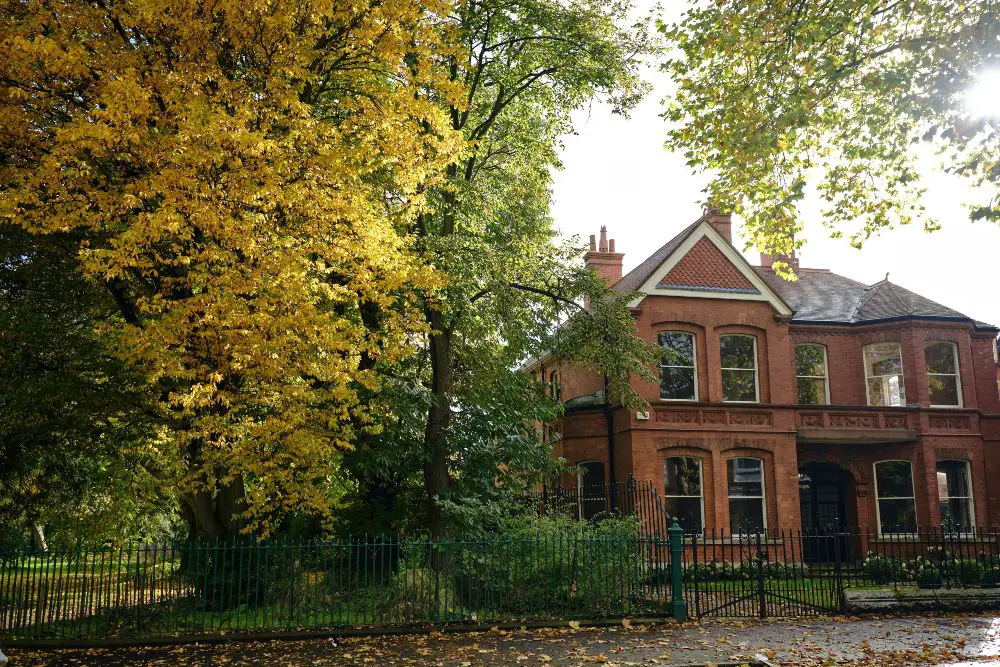
High ceilings and large windows are a staple in Victorian homes, giving the rooms a sense of openness and grandeur. These windows, often adorned with stained glass, allow natural light to flood the interiors, illuminating the rich colors and textures used in the decor. The ceilings themselves are a work of art, with decorative plasterwork and medallions that draw the eye upward, adding to the sense of height and space.
Fireplaces in Victorian homes are much more than a heat source; they are central to the design of the living areas. Often made of marble or surrounded by intricate tile work, these fireplaces serve as a majestic focal point in the room. Mantelpieces are frequently ornate, sometimes featuring carved figures or elaborate floral designs, reflecting the era’s love for detail.
Woodwork is another critical element of interior design in Victorian homes. This includes hand-carved staircases that are not just a means of moving between floors but a display of craftsmanship and artistry. Paneled walls add depth and texture to the rooms, often featuring intricate patterns and carvings.
The furnishings in Victorian homes are selected to complement the opulence of the architecture. This typically includes heavy, ornate furniture with curved lines and elaborate details. Fabrics are luxurious and rich, with heavy drapes, plush carpets, and upholstered pieces featuring intricate patterns and deep, vibrant colors.
Victorian homes often contain a mix of styles, reflecting the era’s eclectic tastes. This can include Oriental rugs, exotic curiosities, and artwork from around the world, alongside more traditional Victorian pieces. This blend of styles adds to the unique character of each home, making it a reflection of its owner’s tastes and the era’s global influences.
Overall, the interior design of Victorian homes is characterized by its elegance, richness, and attention to detail, with each element carefully chosen to reflect the status and style of the era.
Exterior Design
The exterior design of Victorian homes is a visual feast, characterized by an array of ornate and elaborate features. These homes stand out for their intricate designs and bold aesthetic choices, making a lasting impression.
Ornate facades are a defining characteristic of Victorian homes. These facades are adorned with decorative trims and moldings that showcase the era’s love for detailed craftsmanship.
Features such as scalloped shingles, patterned masonry, and carved woodwork are common, adding texture and depth to the home’s exterior. The use of different materials and finishes creates a layered look that is both complex and aesthetically pleasing.
Asymmetry plays a significant role in the design of Victorian homes. This is evident in the irregular placement of windows and doors, and the varied shapes and sizes of the structures themselves.
The use of turrets and towers adds a dramatic touch, often giving homes a castle-like appearance. These features not only contribute to the unique silhouette of Victorian homes but also create interesting interior spaces.
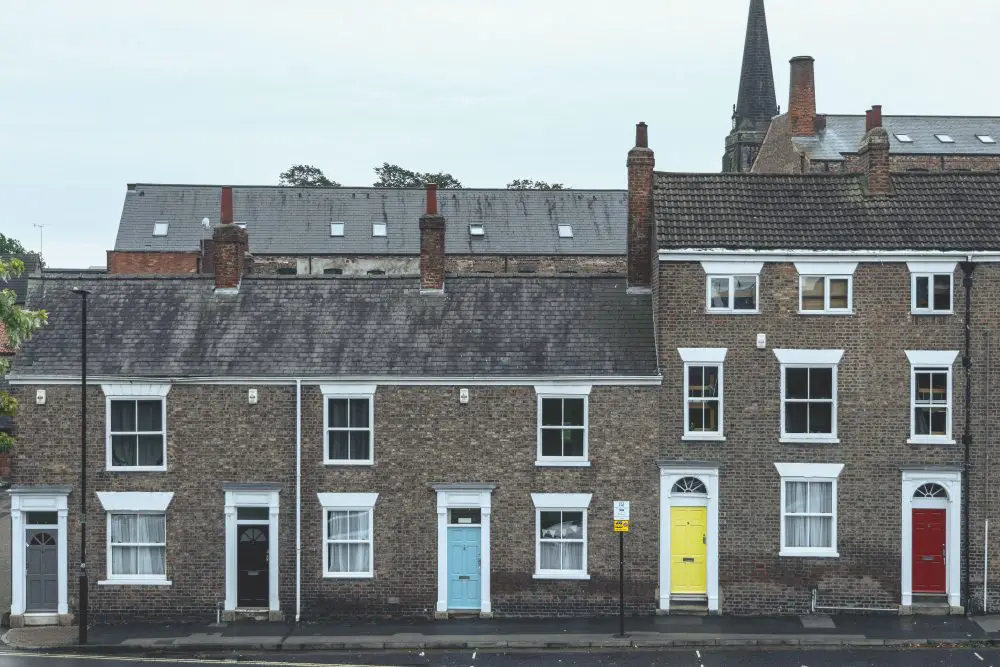
Wrap-around porches are another hallmark of Victorian home design. These porches, often ornately decorated with spindles and brackets, extend the living space outdoors, providing a seamless transition between the interior and exterior. They serve as gathering spaces for social interaction and relaxation, reflecting the Victorian era’s emphasis on community and family.
The roofs of Victorian homes are typically high-pitched and adorned with gables, dormers, and finials. These elements add to the vertical emphasis of the architecture, creating a sense of height and grandeur. Stained glass windows are frequently used, adding color and artistic flair to the exteriors. These windows not only beautify the homes but also tell stories through their designs, reflecting the personal tastes and values of the homeowners.
The color schemes of Victorian homes are often bold and eclectic, with a mix of complementary and contrasting hues used to highlight the architectural details. This polychromatic approach was a departure from the more subdued color palettes of earlier architectural styles and is a signature element of Victorian aesthetics.
The gardens and landscaping of Victorian homes are designed with the same attention to detail and elegance as the houses themselves. Manicured lawns, well-tended flower beds, and decorative fencing create a cohesive look that enhances the home’s overall appeal. The landscaping is often designed to complement the architectural style of the home, with pathways, fountains, and ornamental plants adding to the beauty of the property.
In summary, the exterior design of Victorian homes is a testament to the architectural creativity and artistry of the Victorian era. Each element, from the ornate facades to the manicured gardens, contributes to the distinct and enduring appeal of these historic residences.
Influence on Modern Architecture
The impact of Victorian homes on modern architecture is both profound and enduring. These historical structures have inspired contemporary designers and architects, influencing the way we think about space, design, and aesthetics.
One of the most significant influences of Victorian architecture on modern design is the emphasis on detail and craftsmanship. In an age where minimalism and streamlined designs are prevalent, Victorian homes remind us of the beauty and importance of intricate details and ornamentation.
Modern architects often draw inspiration from the elaborate woodwork and decorative elements of Victorian homes, incorporating these features into contemporary designs to add character and depth.
The eclectic nature of Victorian homes, with their blend of different styles and influences, has also impacted modern architecture. This approach encourages architects to experiment with diverse styles, integrating various historical elements to create unique, hybrid designs.
The blend of past and present in architecture can be seen in many modern buildings, where traditional motifs are reimagined in a contemporary context.
The use of color in Victorian homes has influenced modern architecture as well. The bold and varied color schemes of Victorian exteriors have inspired contemporary architects to use color more adventurously. Instead of the monochromatic or neutral palettes that have dominated much of 20th-century architecture, more buildings today feature vibrant colors and contrasts, echoing the Victorian aesthetic.
The concept of personalized spaces, a hallmark of Victorian home design, resonates strongly in modern architecture. Victorian homes were often designed to reflect the personalities and preferences of their owners. The design is more on aesthetics and style apart from just function or covering the bare basics of a house. This results in the evolution of interior design that takes into account the homeowner’s taste and preference.
Modern architecture is partly influenced by Victorian homes with its design style and use of sturdy materials. Their importance has led to the call to preserve as many Victorian buildings as possible by retrofitting older buildings. This has encouraged sustainable practices in modern architecture, such as repurposing existing structures and preserving historical elements in new designs.
In summary, Victorian homes have had a lasting impact on modern architecture. Their rich details, eclectic style, bold use of color, and emphasis on personalization continue to inspire contemporary design. The legacy of Victorian architecture demonstrates how historical styles can inform and enrich modern architectural practices.
FAQs About Victorian Homes
What defines a Victorian home?
Victorian homes are known for their ornate facades, asymmetrical designs, and elaborate detailing. Common features include high-pitched roofs, turrets, and decorative trims.
When were Victorian homes popular?
Victorian homes were most popular during Queen Victoria’s reign, roughly from 1837 to 1901, coinciding with the Victorian era.
Are Victorian homes energy efficient?
Original Victorian homes may not be as energy efficient as modern buildings due to their age and construction methods. However, many have been updated or can be retrofitted to improve energy efficiency.
What are some common challenges of owning a Victorian home?
Maintaining a Victorian home can be challenging due to the need for specialized upkeep of historical features and potentially higher costs for repairs and renovations.
How have Victorian homes influenced modern architecture?
Victorian homes have influenced modern architecture through their eclectic style, detailed craftsmanship, and bold use of color. They’ve inspired a blend of historical elements in contemporary designs.
Can Victorian homes be modernized?
Yes, Victorian homes can be modernized while preserving their historical charm. Many homeowners update the interiors with modern amenities while maintaining the exterior’s architectural integrity.
Why are stained glass windows popular among Victorian homes?
Stained glass windows in Victorian homes are not just decorative but also tell stories and add a unique character to the house, often reflecting the personal tastes of the owners.
Are all Victorian homes large and elaborate?
While many Victorian homes are large and elaborate, there are also smaller, less ornate versions, reflecting the variety within Victorian architecture.
How can I identify the style of a Victorian home?
From outside the house, you will notice the exterior design’s asymmetrical patterns and use of an ornate facade. Victorian houses may also have stained glass windows and turrets on their roofs.
Is it expensive to maintain a Victorian home?
Maintenance costs for a Victorian home can be higher than average due to the specialized care needed for historical features and potentially older construction materials.
Conclusion
Victorian homes stand as a testament to an era of architectural innovation and grandeur. Their distinctive style, characterized by ornate facades, intricate detailing, and eclectic design, continues to captivate admirers and influence modern architecture. These homes have made an impact on all architectures that have incorporated part of the Industrial Revolution philosophy into their design.

